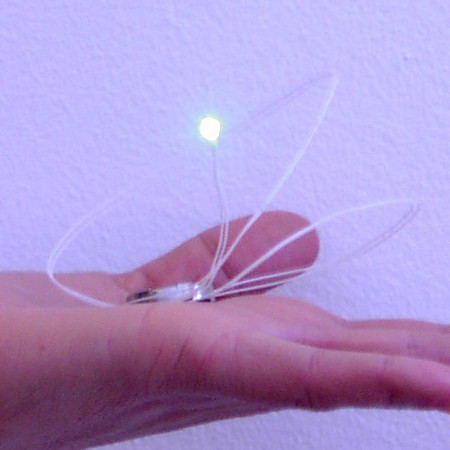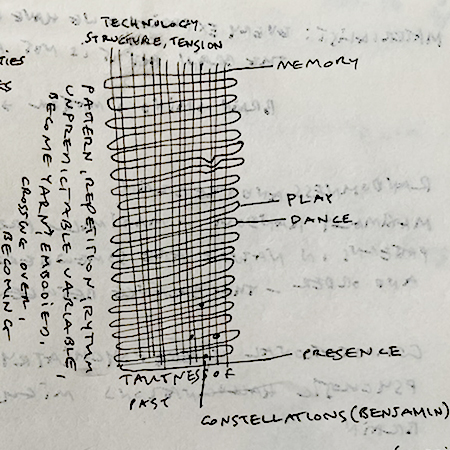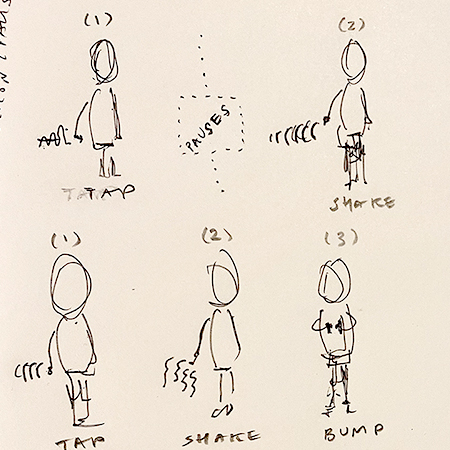 1. Love Jackets, Despina Papadopoulos, 1997
1. Love Jackets, Despina Papadopoulos, 1997
 2. Weaving on a Jacquard Loom from 1890, conductive yarns & cotton. The loom was restored by the viola da gamba musician and polymath, Andreas Linos, and was part of Danke, a performance produced by the SUM creative team and as part of the the 2021 Athens Epidaurus Festival.
2. Weaving on a Jacquard Loom from 1890, conductive yarns & cotton. The loom was restored by the viola da gamba musician and polymath, Andreas Linos, and was part of Danke, a performance produced by the SUM creative team and as part of the the 2021 Athens Epidaurus Festival.
 3. Courtly Bags, Despina Papadopoulos in collaboration with As Four, 2001
3. Courtly Bags, Despina Papadopoulos in collaboration with As Four, 2001
 4. Day-by-Night, a solar powered dress in tribute to Paco Rabanne, Despina Papadopoulos, 2004
4. Day-by-Night, a solar powered dress in tribute to Paco Rabanne, Despina Papadopoulos, 2004
 5. Moi, Studio 5050, 2001
5. Moi, Studio 5050, 2001
 6. Punching cards for jacquard loom to code a weaving pattern, 2019. Made possible by Mirsini Linou & Andreas Linos.
6. Punching cards for jacquard loom to code a weaving pattern, 2019. Made possible by Mirsini Linou & Andreas Linos.
 7. On Skin and Us, conductive yarns, cotton, Despina Papadopoulos, 2020
7. On Skin and Us, conductive yarns, cotton, Despina Papadopoulos, 2020
 8. Notes on the encounter, between the warp and the weft – ink on paper, Despina Papadopoulos, 2019
8. Notes on the encounter, between the warp and the weft – ink on paper, Despina Papadopoulos, 2019
 9. Prototype for Interoceptive Haptic Device, Despina Papadopoulos for Empathic Technologies, 2021
9. Prototype for Interoceptive Haptic Device, Despina Papadopoulos for Empathic Technologies, 2021
 10. Banging My Head on the Wall, video, 49 secs, Despina Papadopoulos, 2019
10. Banging My Head on the Wall, video, 49 secs, Despina Papadopoulos, 2019
 11. Untitled, video loop, 7 secs, Despina Papadopoulos, 2019
11. Untitled, video loop, 7 secs, Despina Papadopoulos, 2019
 12. Weaving fabric for Gestures of Gestures, on a semi-automatic ARM loom (woven by master weaver Stefanie Seitinger), 2022
12. Weaving fabric for Gestures of Gestures, on a semi-automatic ARM loom (woven by master weaver Stefanie Seitinger), 2022
 13. Electronic components for Embodied Interactions – Despina Papadopoulos in collaboration wih Ling Tan and with a grant from HDI, 2019-2020
13. Electronic components for Embodied Interactions – Despina Papadopoulos in collaboration wih Ling Tan and with a grant from HDI, 2019-2020
 14. Embodied Interactions, Despina Papadopoulos in collaboration wih Ling Tan and with a grant from HDI, 2019-2020
14. Embodied Interactions, Despina Papadopoulos in collaboration wih Ling Tan and with a grant from HDI, 2019-2020
 15. Embodied Interactions, Despina Papadopoulos in collaboration with Ling Tan and with a grant from HDI, 2019-2020
15. Embodied Interactions, Despina Papadopoulos in collaboration with Ling Tan and with a grant from HDI, 2019-2020
 16. A Philosopher Talks to the Machine, 2021: “Philosophers often behave like children who scribble some marks on a piece of paper at random and then ask the grown-up. “What’s that?” – It happened like this: the grown-up had drawn pictures for the child several times and said: “this is a man”, “this is a house”, etc. And then the child makes some marks too and ask: what’s this then?” Ludwig Wittgenstein, Culture and Value – ink on paper, Despina Papadopoulos, 2020
16. A Philosopher Talks to the Machine, 2021: “Philosophers often behave like children who scribble some marks on a piece of paper at random and then ask the grown-up. “What’s that?” – It happened like this: the grown-up had drawn pictures for the child several times and said: “this is a man”, “this is a house”, etc. And then the child makes some marks too and ask: what’s this then?” Ludwig Wittgenstein, Culture and Value – ink on paper, Despina Papadopoulos, 2020
 17. Shake, Bump, Tap, part of Gestures of Gestures – ink on paper, Despina Papadopoulos, 2020
17. Shake, Bump, Tap, part of Gestures of Gestures – ink on paper, Despina Papadopoulos, 2020
 18. Notes on Stillness – ink on paper, Despina Papadopoulos, 2020
18. Notes on Stillness – ink on paper, Despina Papadopoulos, 2020
 19. Un coup de des jamais n’abolira le hasard, Mallarmé, 1897
19. Un coup de des jamais n’abolira le hasard, Mallarmé, 1897
 20. Minkyung Sim et al., “Electronic Skin to Feel ‘Pain’: Detecting ‘Prick’ and ‘Hot’ Pain Sensations,” Soft Robotics, July 23, 2019
20. Minkyung Sim et al., “Electronic Skin to Feel ‘Pain’: Detecting ‘Prick’ and ‘Hot’ Pain Sensations,” Soft Robotics, July 23, 2019
 21. Wet Wool, color photo, Despina Papadopoulos, 2022
21. Wet Wool, color photo, Despina Papadopoulos, 2022
 22. Pattern Recognition, black and white photos, Despina Papadopoulos, 2023
22. Pattern Recognition, black and white photos, Despina Papadopoulos, 2023
 23. Teleportation, black and white photos, Despina Papadopoulos, 2023
23. Teleportation, black and white photos, Despina Papadopoulos, 2023
 24. Stitches, black and white photo, stainless steel conductive yarn, Despina Papadopoulos, 2023
24. Stitches, black and white photo, stainless steel conductive yarn, Despina Papadopoulos, 2023
As an artist, designer and researcher I find myself in constant dialogue with embodied sensing systems and emerging materials and their relationship to meaning making.
I am particularly concerned with the proliferation of algorithmic logics as developed in AI emotion recognition systems and affective computing applications, and the implications that such logics hold: confined, limited and static models of being, political and social biases propagated, ontologies that disregard the plural, the complex, the Other.
I weave these themes together into what I call The Unruliness of Matter, through a variety of practices, gestures and techniques, by conversing with materials and exposing their unruly, unpredictable and poetic nature, best manifested in their entanglement with the world they inhabit.
I posit this unruliness in direct opposition to the tame, linear, indexical schemas technological systems adopt as they seek to turn the mutable, variable and complex into the contained, legible and measurable.
I started exploring these ideas by developing wearable environments and seeking to introduce sculpturality, a sensory multi-dimensionality, beauty, playfulness, and a performative experimentation to the process of making – and in the process coming in terms with the unexpected and the unpredictable, working towards an ontology of unknowability – so this unruliness of matter is put forward as model through which to reframe and inform new types of relationships to technology.
This reframing starts with the ENCOUNTER, an encounter between the symbolic and the literal, between practices, between the language that machine learning models rely on, and that of poetry and motion, that also grounds my first research question:
– What does it mean to encounter across and among materialities? and
– How can this encounter rethink of the grid as an affective topology?
I started making video essays to answer these questions: using my phone as an extension of my subconscious/conscious/body, no tripod, no props a material witness: I bang my head on the wall using an energy absorbing engineered material, unruly atoms in motion enable a visceral, embodied and literal enaction of language to take place, trauma performed and yet deferred, this is not a Marina Abramovich moment, instead it is a moment that looks at engineered structures as an active rethinking of how technological environments could support enactments of plurality and emergence. the encounter here is one of cognitive dissonance, “trying things out” to see how the world responds and where a truly adaptive system emerges.
I wanted to further explore this performative experimentation, and the role of the unconscious, the looping dance of agency, diving into the material theater – a leap: I had a dream, terribly precise, the outfit exact, the sky bright and deep, dark and menacing, taking place at the beach where I spent countless summers as a child: I reenact the dream EXACTLY in a single take – joy, playfulness, surrender, despair, immersed into matter, a different kind of looping takes place here, a different kind of weave this time, and of unruliness – whose?
I sought to bring these notions of adaptivity, play, convergence and indecipherability – or of meaning being deferred, back to the loom, this time by creating a responsive material that sits close to the body: back on the loom the tautness of the wrap is traversed by new materials on the weft: conductive yarns, cut-resistant ones, reflective ones (also referred to as high performance yarns).
I connect the conductive yarns to custom-made electronics and an Arduino that runs a machine learning model using Tensor Flow (an open source library for machine learning), with the aim of developing a type of “conversation” between human and machine, training the model to respond to a set of gestures by heating up different sections of the fabric and in varied attenuations – from a pleasant warm tingle to an almost aggressive painful heat sensation.
While the affective relationship between a computational material and the human skin that emerges is primary to the experimentation in the practice, it is in the process of making this complex and novel structure that important questions emerge, questions that magnify the divergence between the human & machine ontology and epistemology, and an attempt to foreground a performative ontology between the two that frames the second research question:
What is the Connection between Machine Learning and Gesture and how does this relationship affect what Connecting with other intelligences could entail?
1. How does the Define – Capture – Train – Perform sequence of Machine Learning relate to that of human performativity?
2. What makes a gesture legible for human, what for machine?
3. How is stillness and pause understood by the two actors? How can the stillness and spaces in between that make so much of being and poetry be understood by the machine?
How is the sensory grid that the sleeve creates, where craft and beauty and pain is present, is different to the grid of the sensor array as “tactile sensor system that is capable of detecting or generating “pain” that scientists in soft robotics claim to have developed at the DGIST in Korea? And then, one more step – what is it that they are both missing?
In “Pattern Recognition” I come close to an answer – I adopt the gaze of the machine, I scan my environment, but this time laden with affective context, with care, concern, random connections between shapes: I hang a freshly washed sweater and as the heat in the room pushes the water off the wool sweater, as the heaviness of the water gives the material an oscillating, almost sensual and unpredictable motion, the unruliness and capriciousness of matter appears in front of me, I keep confusing it with my dog Milo (the two animals, animate and inanimate now meet)
I tile and reshuffle the sequence: this is another kind of skin, another kind of grid, sensual, tender, abbreviated and expanded. I ask the machine: do you see what I see? Could you see what I see if you have not internalised a situational awareness that is borne out of concern, friendship and emotion, none of which are performed as emotional or biological markers?
As I take photos, print them, assemble and reassemble them, take photos of photos – the gestures of the tools leave their own imprint on this conversation I have with machine learning. This is another type of weaving, another type of fascination with the grid, the wrap and the weft, the aura of the material,
and its ceaseless reconfigurable unruliness.— the aura and imprint, the gesture of the tool.
And this leads to the final research question, which flows from the other two: how do we look at the gestures of the tool as informing the logic of technology, something that I explore through the series of transitional objects and hybrid materialities I develop.
the unruliness of matters:
the brute force of algorithm
versus the building blocks of being
(caught between the warp and the weft)